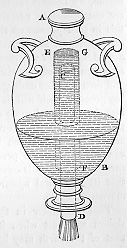THERE is another kind of siphon called the concenedtric or inclosed diabetes, the principle of which is the same as that of the bent siphon. As before, let there be a vessel, A B (fig. 2), containing water. Through its bottom insert a tube,C D, soldered into the bottom and projecting below. Let the aperture c of the siphon approach to the mouth of the vessel A B, and let another tube, E F, inclose the tube C D the distance between the tubes being every where equal, and the mouth of the outer tube being closed by a plate, E G, a little above the mouth C. The lower opening of the tube E F must be so far removed from the bottom of the I vessel as to leave a passage for the water. These arrangements being completed, if we exhaust, by suction through the mouth D, the air in the tube C D, we
 shall draw into it the water in the vessel A B, so that it will flow out
through the projection of the siphon until the water is exhausted. For
the air contained between the liquid and the tube E F, being but little,
can pass into the tube C D, and the water can then be drawn after it. And
the water will not cease flowing because of the projection of the
siphon below -if, indeed, the tube E F were removed, the discharge would
cease on the surface of the water arnving at c, in spite of the
projection below; but when E F is entirely immersed no air can enter the
siphon in place of that drawn off, since the air which enters the vessel
takes the place of the water as it passes out -the discharge then, will
not cease, for the whole of the outer aperture of the tube, where the
water issues forth, is always lower than the surface of the water in
the vessel, and, as one level can never he attained, all the water is
drained off, attraction being exerted by the deeper column. If we do
not choose to draw out the air in the tube C D by suction, water may be
poured into the vessel A B until, when it has risen above C, a discharge
begins through C D. In this case, again, all the water in the vessel
will be drawn out. This instrument is called, as we said before, the
inclosed siphon, or the inclosed diabetes.
shall draw into it the water in the vessel A B, so that it will flow out
through the projection of the siphon until the water is exhausted. For
the air contained between the liquid and the tube E F, being but little,
can pass into the tube C D, and the water can then be drawn after it. And
the water will not cease flowing because of the projection of the
siphon below -if, indeed, the tube E F were removed, the discharge would
cease on the surface of the water arnving at c, in spite of the
projection below; but when E F is entirely immersed no air can enter the
siphon in place of that drawn off, since the air which enters the vessel
takes the place of the water as it passes out -the discharge then, will
not cease, for the whole of the outer aperture of the tube, where the
water issues forth, is always lower than the surface of the water in
the vessel, and, as one level can never he attained, all the water is
drained off, attraction being exerted by the deeper column. If we do
not choose to draw out the air in the tube C D by suction, water may be
poured into the vessel A B until, when it has risen above C, a discharge
begins through C D. In this case, again, all the water in the vessel
will be drawn out. This instrument is called, as we said before, the
inclosed siphon, or the inclosed diabetes.